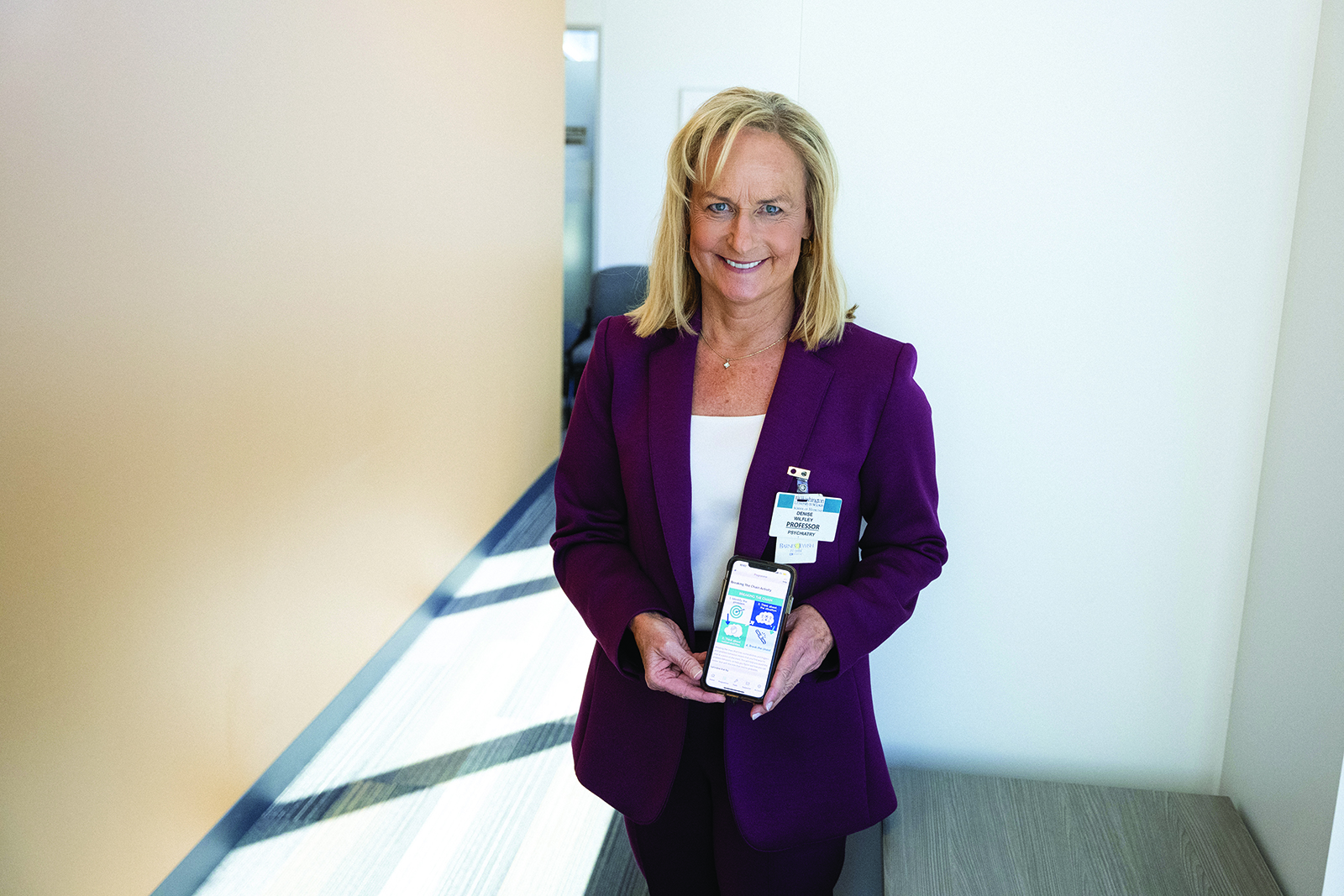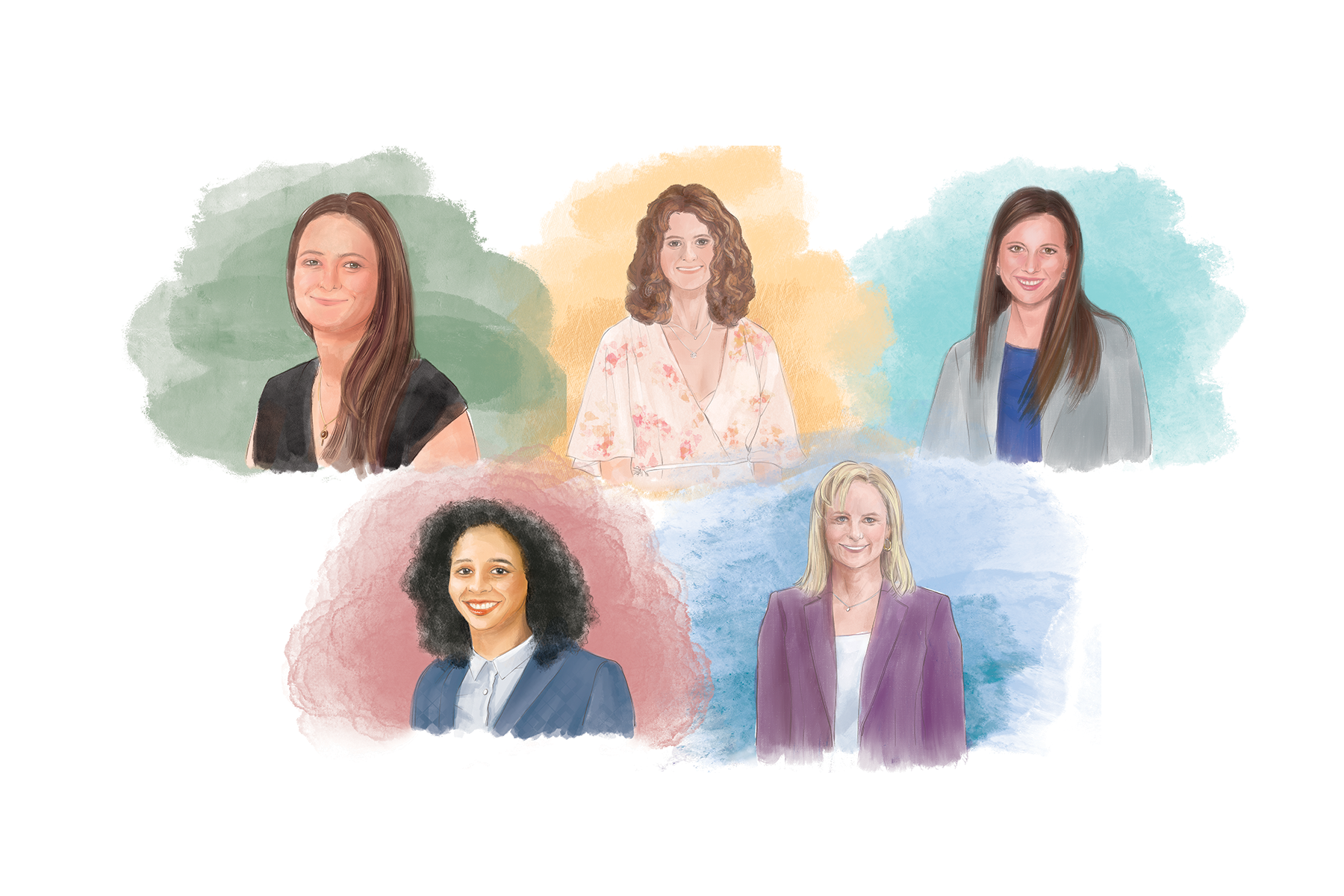Alumni from the Department of Psychological & Brain Sciences are leading the way toward accessible mental health care for all.
When Myra Altman, PhD ’17, transitioned from clinical psychology to the tech world, joining what was then a five-person, San Francisco-based start-up called Modern Health, she decided to conduct a small experiment. Altman called 50 mental health providers listed through her insurance plan to make an appointment. Just two called back. Both informed her that they had no openings for new patients.

“I wanted to get my head around the magnitude of the problem,” Altman recalled. “I thought that since I’m a psychologist and I know the space pretty well, it shouldn’t be that hard for me to find support. Had I been experiencing severe depression, I’m not making those 50 calls in the first place.”
Four years later, Modern Health provides one-to-one, group, and digital mental health services to companies and their employees around the globe. Altman serves as vice president of clinical strategy and research.
The rapid expansion of Modern Health illustrates the high demand for mental health support, especially digital health interventions, or DHIs, geared toward mental health. Such solutions hold promise for reaching wide swaths of people across age ranges and geographic locations who might not have easy access to care. They also offer ways to ease the burden of overworked psychologists by providing those with less acute mental health needs additional options for support. However, challenges abound in developing these tools and making sure that high-quality, evidence-based DHIs reach the many people who might benefit.
On the path toward greater mental health through digital tools, Arts & Sciences alumni are leading the way.
Mental health and the smartphone generation
As a project coordinator for the Lab for Scalable Mental Health at Stony Brook University, Arielle Smith, AB ’22, considers DHIs a powerful way to bring mental health care to teens and young people, in particular.
While still an undergraduate, Smith helped develop a chatbot for eating disorder prevention that is now available through the National Eating Disorders Association. She also published research on how notifications and other factors impact young peoples’ engagement with mental health apps.
Despite nearly ubiquitous smartphone usage among young people, reaching this group still presents a challenge. Even when young people discover effective self-help tools, users frequently drop off before finishing a digital program designed to be used over multiple sessions or over an extended length of time. Smith’s current work considers an alternative approach.
“A different perspective is thinking, what if we don’t have this many sessions to begin with? What if we lower the intensity of the intervention and focus on effects that can occur in a shorter amount of time?” she asks.
Smith now provides support for Stony Brook researcher Jessica Schleider, who develops single-session interventions, or SSIs, geared toward teens with depression. These interventions transmit evidence-based information, using proven strategies like saying-is-believing exercises, in a single session that can be completed in around 30 minutes — a great option for those who might seek help on the spur of the moment but not want to commit to an extended program.
Smith came to this work through her own struggles with depression as a young teen. Despite having a supportive family environment, she says that it took courage to approach her parents to ask for professional help at age 14.
“Had I not been able to get that support, I think my life would look a lot different right now,” said Smith. “And I know that I’m in that very privileged position. Many teens don’t feel like they can reach out to their parents, so putting things out there that they can access themselves, that’s huge — especially for prevention, so that people don’t have to get to the point where they’re struggling so much and unable to function. These digital mental health platforms are filling a huge gap in our mental health system.”
The scalable solution
Digital mental health interventions exist in a variety of forms. Standalone apps, online self-help tools, websites, chatbots, and text-messaging services all fall under the rubric. Some companies, like Modern Health, offer virtual one-on-one appointments with a coach or therapist alongside digital tools and group-based support. All DHIs promise scalability: the potential to reach more people in need than possible through in-person care alone.
Andrea Kass Graham, AB ’07, PhD ’15, thinks a lot about scalability. As an assistant professor at Northwestern University and part of the university’s Center for Behavioral Intervention Technologies, Graham specializes in implementation science, or the study of how to best disseminate research findings into everyday life. She credits her focus in this area to her training at WashU, where she received undergraduate degrees in psychology and English before returning for her doctorate.
“My tagline is that I really think about how we create access to scalable mental health care. I’m passionate about reach,” she said. “Products that are developed in research have a harder time getting to market, and I think a lot about those challenges.”
At Northwestern, Graham leads an online program focused on binge eating and weight management. A separate project considers how physicians might most effectively guide patients in a rural setting to a depression and anxiety app. Another line of research examines how collaborative design and university-industry partnerships could make evidence- based mental health apps more engaging and, thus, more likely to be broadly adopted even when pitted against thousands of less effective tools available online.
"How do we create engagement that’s not just the number of clicks?"
Yet another means to achieve scalability, the one pursued by Modern Health, is to set up DHIs as an employer-provided health benefit. Modern Health provides participants with different types of care depending on the person’s mental health needs — one-on-one meetings with a therapist or coach, facilitated group discussions led by a provider, or self- guided online materials. The tiered and personalized format allows clinicians to be paired with those in significant need, while those with less acute mental health needs receive the right level and modality of care for them based on both their needs and preferences.
Graham, the researcher at Northwestern, sees great promise in this approach. “Data suggests that paraprofessional coaches — let’s say bachelor’s-level individuals who have training, but they’re not specialists with a clinical license — are equally effective in delivering these tools,” she said. “It allows for more coaches and more diversity among providers, which is important.”
Juliette McClendon, PhD ’18, views DHIs as a critical opportunity to scale up mental health care in an equitable way. At Washington University, McClendon researched the relationship between mental health and racial equity. She now serves as director of medical affairs at Big Health, a company that offers online therapeutics through apps like Sleepio, which helps people struggling with insomnia, and Daylight, an app for anxiety sufferers.
In 2020, when COVID-19 forced mental health clinics to shut down in-person operations, receiving care suddenly required a stable internet connection and privacy for extended virtual therapy sessions. For many people experiencing poverty, McClendon notes, these new hurdles only added to the long list of impediments to receiving care. Big Health’s apps are less resource-intensive, an important consideration when scaling up in an equitable way.

Addressing the skeptics
Mental health experts are accustomed to some pushback when it comes to DHIs, encountering questions like, “How is it possible to maintain quality as you scale?” and “Shouldn’t everyone have access to ‘real’ therapy?”
“I love and share some of the skepticism,” said Altman. “From my perspective, I want people to be asking those questions, because I think it forces those of us who are doing the work in the tech companies to do much better.” At the same time, she recognizes that “the status quo isn’t working” — and not only due to a provider shortage.
In Modern Health’s onboarding screening, only 44% of participants select one-on-one as their first choice for how to receive care. This data suggests that even if enough therapists suddenly became available, not everyone would want that option. For those who do choose to connect to a therapist through private insurance or on their own, the quality of care varies widely.
“When I work in private practice, nobody is checking up on how my patients are doing,” Altman said. “As an individual practitioner — depending on my training, my background, my priorities, I do whatever quality assurance I think is best. So maybe I’m doing a lot of outcome measurement. Maybe I’m not. Maybe I’m using evidence-based principles. Maybe I’m not.”
In contrast, DHIs allow for more regular and thorough surveying and outcome testing, as well as screening of therapists to become part of a network. Apps themselves also track engagement, and implementation scientists like Graham are actively working toward how to best use that data in a mental health context.
“How do we create engagement that’s not just the number of clicks, but that actually creates an experience for the user that’s helpful, beneficial, and satisfying? We’re really challenging academic researchers who are developing these tools to understand those components,” Graham said.
The Arts & Sciences effect
Altman, Graham, McClendon, and Smith share more than a commitment to scalable DHIs. All four earned degrees from the Department of Psychological & Brain Sciences in Arts & Sciences, and all worked with Denise Wilfley, the Scott Rudolph University Professor and director of the Center for Healthy Weight and Wellness.
“I’m so proud of these alumni and really thrilled to see them, from a humanitarian perspective, taking these science-based strategies and finding creative ways to bring them to populations who suffer and have great need,” said Wilfley. “They’re the next generation. They’re doing phenomenal work. And I think they’re really poised to continue to solve the mental health crisis.”
Wilfley’s involvement in digital mental health solutions spans decades, from the days of CD-ROM in the 1990s to artificial intelligence and virtual reality today. She believes that progress in the field stems from “team-based science,” an approach she imparts on her students. Her lab regularly partners with industry, government, and scholars across WashU and other universities, and Wilfley’s students often join forces with WashU’s Brown School and the School of Medicine on dissemination and implementation research questions.
“The students that we get within the psychology department, whether it’s at the undergraduate or graduate level, are so bright, creative, and motivated. You pair that with this team- based science and a passion to get better access to care — I think that’s the formula for success,” said Wilfley.
Wilfley describes the alumni’s work in digital interventions as “revolutionary,” a label that, while taken as a compliment, bears some weight in the minds of her former students.
“It does really feel like we are on the forefront of something new. Because there’s often no playbook for what we’re doing,” said Altman. “How do you really think about providing robust crisis support for hundreds of thousands of people? It feels like you’re at the forefront, and it also feels like a huge responsibility.”



